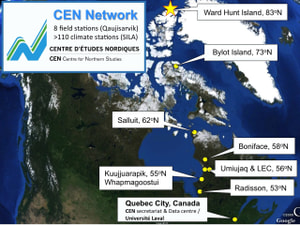We are visiting Whapmagoostui-Kuujjuarapik to investigate the relationship between biodiversity, ecosystem composition and function of tundra. The CEN Whapmagoostui-Kuujjuarapik (KW) station is situated on the coast of Hudson Bay in Nunavik, Quebec, Canada (55° 15' N, 77° 45' W). This place is a southern part of the Arctic tundra. Inuit and Cree First nation are living here. Inuit called Kuujjuarapik this place and Cree First Nation living here called Whapmagoostui. So there are two names at this place. Population is about 1400. There is a grocery supermarket and we can get almost anything as if we are in Japan.
The station has been operated since the 1970’s. In 2010, major renovation of the station was undertaken. A total of 13 rooms (laboratories, storage rooms and so on) and a dormitory (28 beds) are available. Solar panels place to save energy. There are wet and dry labs equipped with drying oven, electric scale, microscope, glassware and so on. Researchers can also borrow field camping gears, ATVs and boats. This station functions as educational base as well as scientific base. It has been used by field courses in Laval University, for example.
The station is managed by Maxime Saunier, the station manager, one or two additional staff, and a cock during summer. Their kind support makes our stay and field investigation easier.
Shota Masumoto
(Yokohama National University, A member of Theme 6)

Staffs of KW station and Japanese researchers

Map of Whapmagoostui-Kuujjuarapik (The third from the bottom)





